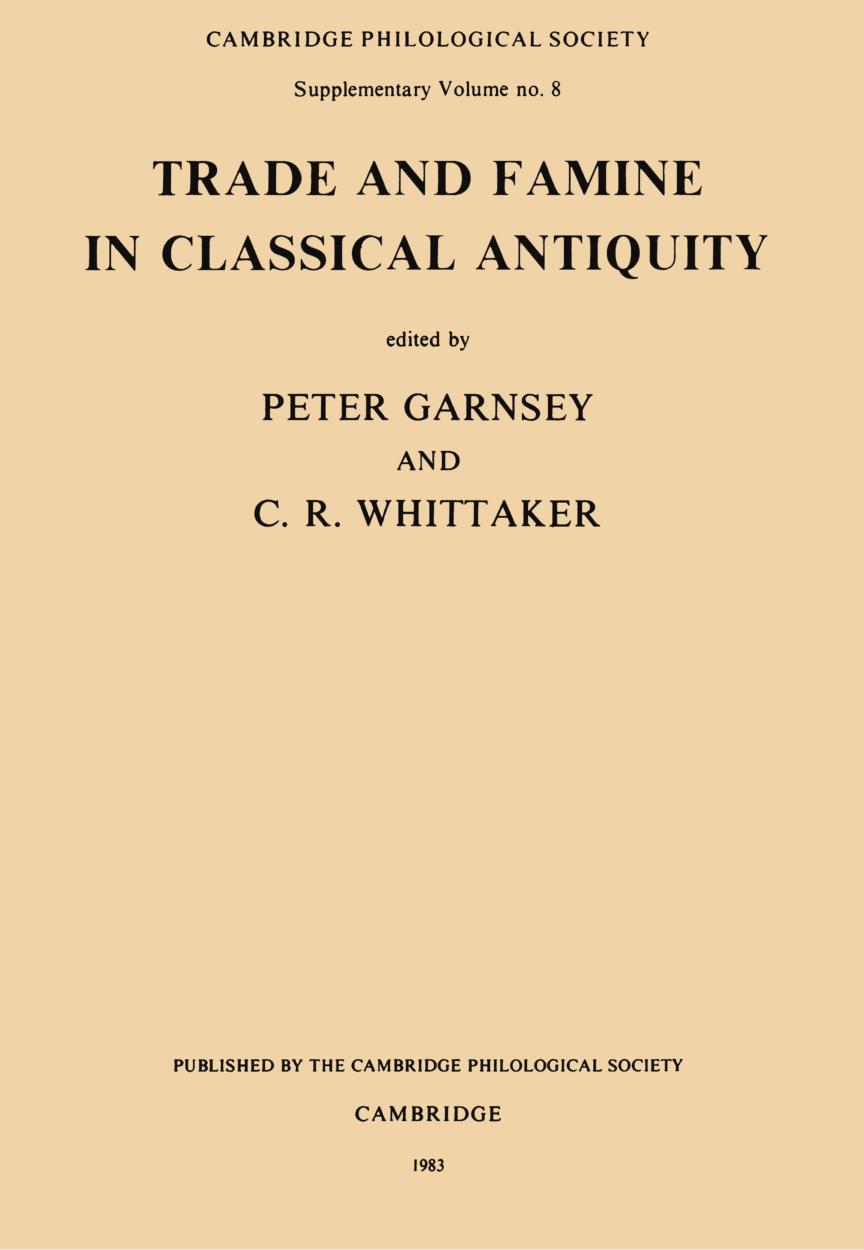Trade and Famine in Classical Antiquity by C. R. Whittaker;Peter Garnsey;

Author:C. R. Whittaker;Peter Garnsey;
Language: eng
Format: epub, pdf
Tags: -
Publisher: Casemate Publishers & Book Distributors, LLC
NOTES
1. I make no attempt to provide a full bibliography for the matters treated in this paper, and I leave aside completely literature from other historical periods. The following books are particularly to be recommended: D. van Berchem, Les distributions de blé et dâargent à la plèbe romaine sous lâempire (1939); P. A. Brunt, Italian Manpower, 225 B.C. â A.D. 74(1971), esp. 376ff., 703ff.; A. Cameron, Bread and Cireuses: the Roman Emperor and his People (1974); H. Pavis dâEscurac, La prefecture de lâannone: service administratif impérial dâAuguste à Constantin (1976); K. S. Gapp, Famine in the Roman World from the founding of Rome to the time of Trajan, Ph.D. Thesis Princeton, 1934; A. R. Hands, Charities and Social Aid in Greece and Rome (1968); R. MacMullen, Enemies of the Roman Order (1966), App. A; J. R. Rea, The Oxyrhynchus Papyri, vol. 40 (1973); G. E. Rickman, The Corn Supply of Ancient Rome (1980); H. Schneider, Wirtschaft und Politik: Untersuchungen zur Geschichte der späten römischen Republik (1974); P. Veyne, Le pain et le cirque (1976).
For the late Empire, which I largely omit, see A. Cameron, Circus Factions (1976); J.-M. Carrié, âLes distributions alimentaires dans les cités de lâempire romain tardif, MEFR 87 (1975), 995-1101; A. H. M. Jones, Later Roman Empire (1966) 695ff.; H. P. Kohns, Versorgungskrisen und Hungerrevolten im spätantiken Rom (1961); L. Ruggini, Economia e società nellâItalia annonaria (1961); E. Tengstrom, Bread for the People, Studies of the corn-supply of Rome during the late Empire (1974).
2. T. Shanin, âThe Nature and Logic of the Peasant Economyâ, Jl. Peas. Stud. 1 (1973) 63-80.
3. The only detailed account is by Gapp (n. 1) and regrettably unpublished. While limited in scope and objectives (and quite inadequate as a study of the Roman world, as distinct from the city of Rome), this is a sound, scholarly work, and has influenced the writing of this paper.
4. I pass over here the special problems posed by the accounts of early Rome. Those early food crises did occur (cf. Cato, Origines fr. 77 P) even if the detailed narratives are unreliable.
5. The last two topics are given broad treatment in P. Garnsey, âResponse of government and people to food crisis in the cities of the ancient Mediterranean (500 B.C. â A.D. 600)â, Famine in History Symposium, Vevey, July 1981.
6. Plut. Pomp. 26.2, Cic. de lege Man. 44; de domo 1-32, Att. 4.1, Dio 39.9, Plut. Pomp. 49.4-50.2; etc.
7. The existence of the (?Augustan) lex Iulia de annona, known only from the Digest (48.4), need not have been decisive in this connection. There is no evidence that it was ever enforced.
8. H. Pavis dâEscurac (n. 1) 260ff. argues for regular intervention in the market by the prefect of the corn-supply.
9. After describing the measures, Dio makes brief mention of the distress caused by the food crisis, new taxes and fire, and of open discussion of revolution â but not of riot.
10. A good brief discussion in Cameron, Bread and Circuses (n. 1).
11. Suet. Claud. 18.3-4, 19; Gaius, Inst.
Download
Trade and Famine in Classical Antiquity by C. R. Whittaker;Peter Garnsey;.pdf
This site does not store any files on its server. We only index and link to content provided by other sites. Please contact the content providers to delete copyright contents if any and email us, we'll remove relevant links or contents immediately.
The Daily Stoic by Holiday Ryan & Hanselman Stephen(3086)
The Fate of Rome: Climate, Disease, and the End of an Empire (The Princeton History of the Ancient World) by Kyle Harper(2848)
People of the Earth: An Introduction to World Prehistory by Dr. Brian Fagan & Nadia Durrani(2609)
Ancient Worlds by Michael Scott(2484)
Babylon's Ark by Lawrence Anthony(2421)
Foreign Devils on the Silk Road: The Search for the Lost Treasures of Central Asia by Peter Hopkirk(2377)
The Daily Stoic by Ryan Holiday & Stephen Hanselman(2319)
India's Ancient Past by R.S. Sharma(2275)
MOSES THE EGYPTIAN by Jan Assmann(2264)
The Complete Dead Sea Scrolls in English (7th Edition) (Penguin Classics) by Geza Vermes(2120)
Lost Technologies of Ancient Egypt by Christopher Dunn(2090)
The Earth Chronicles Handbook by Zecharia Sitchin(2082)
24 Hours in Ancient Rome by Philip Matyszak(1965)
Alexander the Great by Philip Freeman(1947)
Aztec by Gary Jennings(1865)
The Nine Waves of Creation by Carl Johan Calleman(1770)
Curse Tablets and Binding Spells from the Ancient World by Gager John G.;(1759)
Before Atlantis by Frank Joseph(1732)
Earthmare: The Lost Book of Wars by Cergat(1707)
